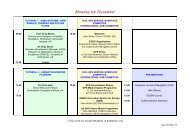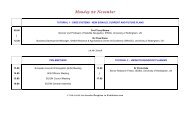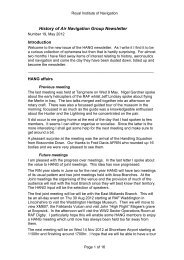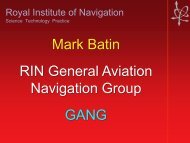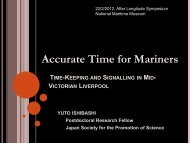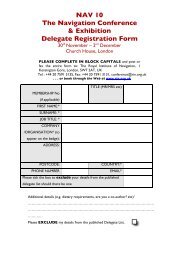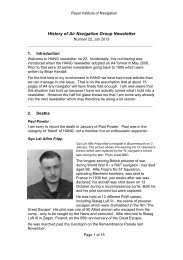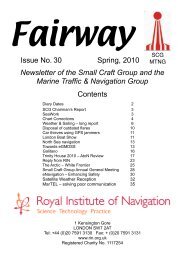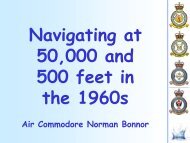VFR Guide - Royal Institute of Navigation
VFR Guide - Royal Institute of Navigation
VFR Guide - Royal Institute of Navigation
You also want an ePaper? Increase the reach of your titles
YUMPU automatically turns print PDFs into web optimized ePapers that Google loves.
Select turning points and fixes, plan radio calls<br />
c. Select a suitable altitude to fly. Decide what minimum altitude you are prepared to<br />
fly at (a safe margin above the highest obstacle near the route), and what minimum<br />
cloudbase you can accept, dividing the route into sectors if you wish. Controlled airspace<br />
may determine a maximum altitude also. Identify areas <strong>of</strong> possible bad weather, and safe<br />
routes to suitable diversion aerodromes if the weather or aircraft unserviceability makes<br />
that advisable. Check these aerodromes are available. Study your selected turning<br />
points and fix points to ensure you can identify them early from your direction <strong>of</strong> travel and<br />
can use them to avoid hazards. Remind yourself <strong>of</strong> the in-flight procedures you will use –<br />
refer to the RIN guide on “Visual <strong>Navigation</strong> Techniques”.<br />
d. Identify information (such as aerodrome and instrument traffic) you should get by<br />
radio, and plan when to ask for it. Practise making the relevant transmissions.<br />
e. Obtain a preliminary weather forecast (perhaps from TV or internet). Make an initial<br />
estimate <strong>of</strong> the time needed for the route in the probable wind conditions. Add a safety<br />
margin <strong>of</strong> at least half an hour (or 20% if greater) at this stage. Calculate the fuel required<br />
for that time. Check the times <strong>of</strong> darkness.<br />
f. Fill in the navigation log/flight planning form with all the information available.<br />
Tracks, distances, safe altitudes, variation, TAS (probably) and fuel consumption rates<br />
can be written down. Identify areas <strong>of</strong> probably high traffic density, such as „funnels‟<br />
through controlled airspace or terrain, or instrument approaches. List the radio<br />
frequencies <strong>of</strong> radar units, aerodromes, controlled airspace, and danger area services<br />
which you may need along the route or in case <strong>of</strong> diversion (check with NOTAMs and the<br />
NATS web site for amendments). List navigation aid frequencies, identification (you may<br />
wish to write down the morse dots and dashes), and protected ranges from the AIP and<br />
NOTAMs. Note any „listening squawks‟ near controlled airspace.<br />
www.rin.org.uk 2 Mar 2012




